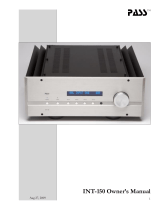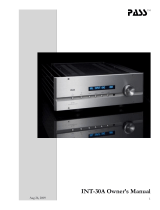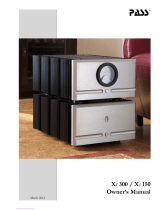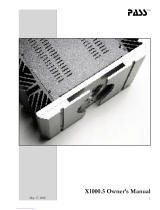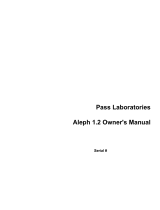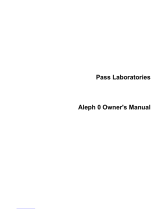Page is loading ...

1
XA200.5 Owner’s Manual
pass
®
XA200.5 Owner’s Manual
October, 2007

2
XA200.5 Owner’s Manual
Nelson Pass has been designing audio electronics since about 1971,
first with ESS (remember Heil transformers?), and then forming a
new company, Threshold in 1975. Threshold pioneered the design
of high power Class A power amplifiers and later, high power
amplifiers using only local feedback (the Stasis series).
Pass sold Threshold and created Pass Laboratories in 1991, where he
concentrated first on elevating single-ended Class A power amplifiers
to new power levels and performance, the Aleph series.
Along the way he found the time to design successful lines of
amplifiers for such companies as Adcom and Nakamichi, and has
contributed approximately 60 designs (so far) to the public “Do-It-
Yourself ” hobbyist community.
Over the years, Nelson Pass has made power, simplicity, and
performance his design signature. The hardware tends to run heavy
and hot, but elicits high performance and reliability from simple
circuits with little or no negative feedback..
In 1998 Pass Labs released the X series of audio power amplifiers,
based on the “SuperSymmetric” topology (U.S. Patent #5,376,899)
which elicits high power and performance from simple circuits with
minimal feedback.
The first X amplifier, the X1000 was intended as the premier
example of the power of this principle, delivering 1000 watts rms
into 8 ohms at low distortion. By itself of course, this is no miracle,
but you have to consider that products with comparable performance
have complicated circuits with as many as nine consecutive gain
stages and lots and lots of negative feedback. The X1000 had only
two stages and used only local feedback.
The difference was the unique balanced circuit topology in which
circuit errors are replicated at both output terminals so as to cancel
and disappear across the loudspeaker terminals. The high quality of
the sound reflects both the low distortion and simplicity of the gain
path.
The SuperSymmetric circuit consists of two identical matched
circuits arranged like the wings of a butterfly, showing symmetry
from left to right, and operating balanced to the loudspeaker. The
amplified signal appears with opposing phase across the loudspeaker.
Most of the distortion and noise appears in phase across the
loudspeaker, and is not seen.

3
XA200.5 Owner’s Manual
We start with simple FET circuits already having low distortion and
noise, and arrange them in two symmetrical halves. The two halves
of the amplifier channel are closely matched, eliminating a large
portion of distortion and noise without feedback. A small amount
of feedback is also applied, not so much for the purpose of reducing
distortion but to make the distortion as identical as possible on both
polarities of the balanced output.
It is easier to make distortions more identical than to remove them
with feedback, and this is the operating principle of X amplifiers.
Since the X1000, Pass Labs products have continuously evolved
toward higher performance. The Class AB “X” series was joined
by the Class A “XA” amplifiers. Subsequent improvements to the
Class AB “X” amplifiers resulted in the “X.5” products, and their
phenomenal success has led to the Class A “XA.5” series.
As always the goal has been the best musical and objective
performance possible with minimal parts in the signal path and
minimal feedback. This process is not completely understood, and
many of the improvements are the result of trial and error and
extensive listening.
Measurement of performance is important to us, and we feel that
well-designed product sounds good and measures good. Apparently
it is possible to make an amplifier which measures well but which
does not please the ears, and so we let our ears be the final judge.
X.5 and XA.5 amplifiers utilize the same basic circuit topology
and gain devices. They differ in the sizes of the power supplies,
the chassis and heat sinks, and the number of output devices. The
output stages of the X.5 series are operated in heavily biased Class
AB, with an idling dissipation similar to the rated output. The XA
amplifiers operate pure Class A with idling dissipation more than
twice the rated output.
Within any given chassis size, the X and XA amplifiers are designed
to dissipate about the same power, and it is not surprising that this
leads to two channel amplifiers with half the output power per
channel of comparable mono amplifiers, and Class A amplifiers with
half the output of Class AB amplifiers.
The X amplifiers deliver more output power per dollar, and the XA
amplifiers have a better subjective performance. All of the amplifiers
drive known loudspeaker loads without misbehaving, and all are
unconditionally stable into low impedance and reactive loads.

4
XA200.5 Owner’s Manual
All the usual performance metrics - power, distortion, noise, input
impedance, damping factor and bandwidth have all been improved
in this latest generation. The power supplies are larger, with fast
rectifiers gating to larger capacitor banks. The increases in AC line
noise worldwide have been addressed with heavier EMI filtering
and dramatically quieter power transformers. In addition, through
improved biasing regulation, the circuits give much more consistent
performance under varying AC line voltages and over a variety of
ambient temperatures.
All this is very nice, but only if it improves your listening experience.
We listen very carefully and critically to our amplifiers with a wide
variety of associated equipment and we take our time with it.
Musical performance is most important, and is the basis of our
success over the years.
It’s true that we also value the other things. The design and
manufacturing decisions have to balance subjective performance
against reliability, cost, specs, and ego (in approximately that order).
That is why we make more than one amplifier, but all are built with
the same commitment to quality.
If you have purchased this amplifier, we thank you for your
confidence, and hope that you enjoy it for many years. If you have
any questions or comments, or if we can help you with your audio
system, pelase don’t hesitate to contact us.
service@passlabs.com
www.passlabs.com
Tel (530) 367 3690
Fax (530) 367 2193
Pass Labs,
PO Box 219
24449 Foresthill Rd,
Foresthill CA 95631

5
XA200.5 Owner’s Manual
SET UP
X amplifiers run at about the same power as their output rating, and
XA amplifier run more than twice that. The heat sinks on the side
of the amplifier run hot to the touch – about 25 to 30 degrees C.
above ambient, so you can expect 50 to 55 degrees C. temperatures
on the heat sinks. It is very important to the long life of the
amplifier that they get good ventilation.
You can put this amplifier anywhere you want, but it must have good
ventilation. Do not place it in enclosed cabinets or small closets
without means for air to circulate freely. Stacking these power
amplifiers directly upon each other is not recommended for the same
reason. You should have a minimum of about 6 inches clearance to
the top and sides for adequate air circulation.
When not actually intending to play music the amplifier should be
left in standby mode, where it draws only a few watts of bias on
the output stage. If you wish to reduce the power draw to 0, you
can shut the amplifier off via the rear panel switch, however we
recommend that for minimum noise this switch should be toggled in
stand-by mode.
We have provided a standard IEC power cord that fits into the
standard 15 amp IEC receptacle at the rear of the amplifier chassis.
With the exception of the largest of the X and XA series, there is no
difficulty running two amplifiers on a single 15-amp circuit. Given
the high current draw, we generally do not recommend active line
conditioners, although they are unlikely to damage the amplifier.
This amplifier is equipped for operation with an earth ground
provided by the users AC outlet. Never defeat this ground
connection. The signal ground of this amplifier is connected to
earth through a power thermistor, which provides a safety ground
but provides isolation from system ground loops.
For maximum safety we suggest that the power cord should be the
last cable installed on your power-amplifier. You may, if you wish,
substitute a 15-amp aftermarket power cord for the one we have
supplied. Only use power cords, which meet all local safety standards
and carry acceptance marks from the local regulatory authority. The
power cord should be attached to the amplifier prior to plugging
into house power. Place the rear mounted switch in the off (down)
position before plugging in this amplifier.

6
XA200.5 Owner’s Manual
The amplifier’s voltage and current rating are indicated on the
rear panel. It will be either 240 volts, 230 volts, 220 volts, 120
volts or 100 volts. The larger amplifiers have a circuit breaker of
the appropriate capacity. The smaller power amplifiers use a slow-
blow 3AG type fuse. The frequency rating of the AC line source
is 50 to 60 Hz. Please verify that the amplifiers indicated voltage
requirements are consistent with the supplied voltage and current at
your location.
On the rear panel you will find both RCA and XLR type input
connections for single-ended or balanced inputs. If you use the RCA
input, be certain that the XLR connector has a gold shorting plug
between pins 1 and 3, which connects the “minus” input to ground,
otherwise the amplifier will not operate properly. If you lose this
plug, just contact the factory – we give them away all the time.
The question comes up all the time – are balanced inputs (XLR)
better than single-ended (RCA)? The answer is that balanced lines
generally give lower noise and slightly less distortion. They are
recommended unless your favorite source component has only RCA
outputs.
Also on the rear panel are the output connections for the
loudspeakers. On stereo amplifiers there is one pair per channel, and
on mono amplifiers we provide two pairs wired in parallel to facilitate
“bi-wiring” a loudspeaker. As you are probably familiar, the red one
is positive polarity, and the black one is negative.
Please note that, being a balanced output, both of these terminals
are electrically live – neither is grounded and should not be treated
as ground. This is particularly important if you are using the
output of the amp to also drive a subwoofer amplifier or other
active component. If there is any question, please contact the
manufacturers of the products involved – both they and we will be
happy to advise you.
If you happen to need a clean signal ground connection for any
reason, we provide a dedicated 5 way binding post just for that on
the rear of the amplifier.
On the rear panel you will also find a pair of 5 way binding posts
for external turn-on control. Applying 5 to 12 volts DC at this
connection will override the front panel stand-by switch and turn the
amplifier on.

7
XA200.5 Owner’s Manual
So the amplifier is sitting there unconnected.
Make sure that the rear panel power switch/breaker is off (down).
Plug the AC cord into the back of the amplifier, and then into the
wall. Then turn the power switch/breaker on (up). The lights in
your house will dim for a moment as the power supply charges the
capacitors.
If your amplifier uses a circuit breaker and not a fuse, please note
that this circuit breaker is not a “safety device” or “emergency
disconnect” for this product. It will provide current limiting which
will protect the amplifier, but it does not provide personal shock
protection in the manner of a ground-fault interrupter. One more
reason why it is important not to defeat the Earth connection of
your power cord.
On the front panel, the “Standby” LED indicator should be glowing
blue, indicating that AC power is available and the capacitor banks
are charged. If the “Power” LEDs are lighting the meter, use the
front panel stand-by button to go to stand-by mode.
Now turn off the rear power switch and unplug the AC power cord
from the wall while you connect the speakers and inputs.
Check to make certain that the loudspeaker cables aren’t shorted at
the loudspeaker end, connect speaker cables to the output binding
posts on the amplifiers, observing correct polarity. The output
binding posts will accept either bare wire or spades. (Regulatory
agencies in many countries have banned binding posts that will
accept a banana plug, forcing us to abandon this option.) Make sure
that your speaker wires only attach to the outputs of the amplifier,
not to each other and never to the amplifier case.
Remember the warning about treating the output connections as
ground, particularly if you are using a powered subwoofer with this
amplifier. If you need a ground, use the one provided specifically on
the rear panel of the amplifier.
The amplifier may be driven single-end or balanced, your choice.
Single-ended input will always occur through the RCA connector and
balanced input will always occur through the XLR connector.
Again, if you drive the amplifier single-ended then leave the supplied
jumpers in place between pins 1 & 3 on the input XLR.
On the XLR connector pin 1 is ground, pin two is positive input and

8
XA200.5 Owner’s Manual
pin 3 is inverted (negative) input. Pin numbers are marked on the
XLR. If you re-install the jumper incorrectly or leave it lying about,
the amplifier will not work properly, and you will be able to tell.
Choose either XLR or RCA inputs. If you run both at once from
different components, the sound is not likely to be optimal, but it
shouldn’t cause damage anywhere.
Now that the source component is connected, turn the volume all
the way down. Plug the power cord back into the wall, and turn on
the rear power switch.
Push the front panel button to activate the amplifier. The lights will
come on.
You are ready to play music
With any luck, you can now enter that blissful state, and we won’t
expect you back for a while.
It’s always possible that something may go wrong. If so, don’t get
excited. We know It’s really aggravating when a product doesn’t
work, but it will get fixed, and often it’s something really simple.
We go to a lot of trouble to make products reliable, and the failure
rate of our amplifiers is very low. This is small comfort to the few,
but take it easy and give us a call if you have problems.
People are interested in how long it takes for these amplifiers to
break in. Depending on the resolution of the rest of your audio
chain, you may or may not notice any break in of the amplifier
beyond the first few hours of operation. You will very likely notice
the difference in sonic character between cold and normal operating
temperature over the first hour, so we recommend letting these
amplifiers warm up before any serious listening.
This generation of amplifiers warms up faster and is more bias-stable
during warm up than previous versions, but we still recommend an
hour for critical listening. At the factory we adjust the bias and offset
values initially and then after warm-up and then again after 48 hours,
If necessary. The “sweet spot” is a sink temperature between 50 and
55 degrees C., but this is not critical, and will vary with your room
temperature. You should be able to put your hands on the heat sinks
without undue discomfort for 5 seconds or so.
The amplifier has a thermal cutout that will disconnect AC power if

9
XA200.5 Owner’s Manual
the temperature exceeds 75 degrees Centigrade. This thermal cutout
should never occur in real life. This is a very rare occurrence, and
would indicate a serious problem.
Interconnects and Speaker Cables
We have a general recommendation about interconnects, and
speaker cables: They should cost less than the amplifier, and contain
at least some conductive material. We have tried a lot of products
and most work well, but as a practical matter we cannot make blanket
recommendations.
The amplifier is not sensitive to source interconnects. It is also not
sensitive to radio frequency pickup, which allows some flexibility in
choosing source interconnects without shields, though shields are
usually a very good idea. For long runs balanced cables are highly
recommended for their inherent rejection of noise.
We prefer speaker cables that are short and stout. Oxygen-free
copper and silver are the suggested materials. If you find any really
exceptional cable made of gold, please gift us a couple hundred feet.
Fortunately this amplifier is not sensitive to the capacitive/inductive
character of some of the specialty speaker cables, so feel free to
experiment.
We have found that about 90 per cent of bad sounding cables are
really bad sounding connections, and we recommend that attention
be paid to cleanliness of electrical contact surfaces and proper
connector fit.
Speaker cables should be firmly tightened down at the speaker
output terminals, but not with a wrench. Output terminals will not
withstand the levels of torque that may be easily applied by wrench.
Hand tightening without excessive force is plenty. Cleaning contact
surfaces with one of the commercially available electronic contact
cleaners should be part of your annual system maintenance.
Product Life
So how long will this hardware last? It is our experience that, barring
abuse or the odd failure of a component, the first things to go will be
the power supply capacitors, and from experience, they will last 15 to
30 years. Fortunately they die gracefully and are easily replaced by a
good technician.

10
XA200.5 Owner’s Manual
After that, the longevity will depend upon the number of operating
thermal cycles, but we can say that we have had amplifiers operating
in the field in excess of 20 years with no particular mortality, and we
don’t have good information beyond that.
More to the point, you should not worry about it. This is a
conservatively built industrial design, not a frail tube circuit run on
the brink of catastrophic failure. If it breaks, we will simply get it
fixed, so sleep well.
Pass Laboratories
PO Box 219
24449 Foresthill Rd
Foresthill, CA 95631 USA
www.passlabs.com
sales@passlabs.com
service@passlabas.com
tel: (530) 367 3690
fax: (530) 367 2193
“pass”, “Pass”, “Pass Labs”, “Pass Laboratories”,
“Supersymmetery”, “Aleph”, and “Zen” and are all registered
trademarks of Pass Laboratories, Inc., and all rights thereto are
protected by law.

11
XA200.5 Owner’s Manual

12
XA200.5 Owner’s Manual
Warranty Information
All Pass Laboratories products purchased new from an authorized
Pass Laboratories dealer in North America are covered by a
transferable, limited 3-year warranty.
This warranty includes parts and labor charges incurred at the repair
facility. Consequential damages are specifically not covered and
damage due to modification or physical abuse is also not covered.
The customer assumes responsibility for shipping and insurance to
and from the factory, or a factory specified repair facility.
Non-North American customers should consult with their original
Pass Labs dealer or distributor for warranty repair instruction prior
to contacting the factory or shipping product for repair. Non-
North American product must be returned to the country of origin
for warranty service. Foreign distributors are only required to
offer warranty service on Pass Laboratories product that they have
imported.
Conditions of warranty service and customer rights for product
purchased outside the United States may vary depending upon the
distributor and local laws. Please check with your local distributor
for specific information.
Any modifications to Pass Laboratories products that have not
received written factory approval nullify all claims and void the
warranty. Should a modified product be returned to the factory for
repair the owner will be required to pay all necessary charges for the
repair in addition to those charges required to return the product to
its original configuration.
In the case of safety issues, no product shall be returned to the
customer without those safety issues being corrected to the most
recent accepted standards.
Removal or alteration of original Pass Labs serial numbers voids the
factory warranty. Product with altered or missing serial numbers
will be suspected as counterfeit product. Pass Laboratories will not
repair or in any way indemnify any counterfeit or cloned product.
Pass Laboratories does not offer products in voltages intended for
international markets either to authorized Pass Labs dealers or to
third parties located in the United States or Canada.

13
XA200.5 Owner’s Manual
Water and moisture: Electrical devices should not be used near
water ( as per example, near a bathtub, washbasin, kitchen sink,
laundry tub, wet basement or swimming pool ). Care should be
taken such that objects do not have the opportunity to fall, and that
liquid is never spilled onto or into the device enclosure through
openings.
Power Sources: An electrical device must be connected to a mains
power source in strict accordance with the supplied product owner’s
manual. Please verify that the AC mains voltage specified in the
product manual matches those requirements indicated on the unit
and the AC voltage provided to your location by the power company.
Grounding: Adequate precautions should be taken so that the
grounding provisions built into an electrical product are never
defeated.
Power Cords: Pass Laboratories provides a power supply cord that
meets all legislated requirements for the market in which the product
was originally sold. If you choose to substitute an after-market
product we urge you to choose one that is fully safety rated by the
necessary local authority.
Power Cord Protection: Power supply cords should be routed so
that they are not likely to be walked on, abraded, or pinched by items
placed on or against them, paying particular attention to cords where
they enter plugs or exit from a device. Never under any circumstance
insert a cut or damaged power cord into a mains power socket.
Power and Signal: Cables should never be connected /
disconnected with equipment powered up. Failure to heed this
warning may damage or destroy equipment.
Ventilation: Power-amplifiers run hot, but you should be able to
place your hands on them without discomfort. You must allow for
this heat in installation, by providing for free air circulation around
the product. Electronics should not be subjected to sources of
excessive radiant heat. Excessive heat can shorten the life of the
product and may cause the electronics to self-protect and shut down.
Servicing: To reduce the risk of fire, electrical shock or other
injuries, the user should not attempt to service the device beyond
that which is described in the operating instructions. All other
servicing must be referred to qualified service personnel.
For your protection please
read the following:
/


